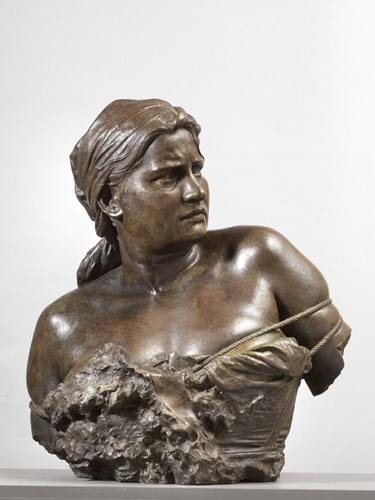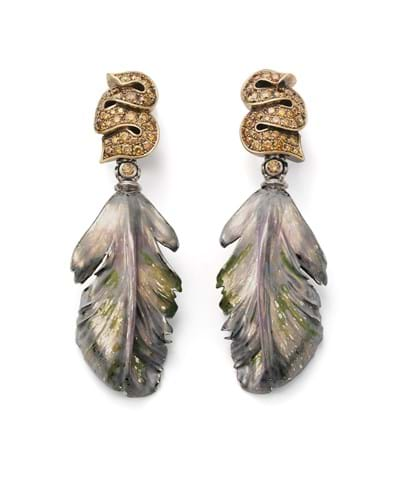The fair returns for its third edition at the Park Avenue Armory from October 27-31. Among its 93 exhibitors are 12 newcomers: Antonacci Lapiccirella Fine Art, Galerie Cybele, Giacometti Old Master Paintings, Sebastian Izzard, Bruce Kapson Gallery, Stephen Ongpin Fine Art, Frascione Arte, Benjamin Proust Fine Art, Librarie Amélie Sourget, Stoppenbach & Delestre, Galerie Florence de Voldére, and Wildenstein.
Here, we have a look at some of the stand-out offerings at the fair brought by new and old exhibitors alike.
A Pétroleuse statue
According to popular mythology in 1871, the pétroleuses burned down much of Paris during the last days of the Paris Commune. The rumour was that this group of lower-class women had harried the capital, throwing Molotov cocktails at government and historical buildings while the loyalist army marched in to recapture it.
In fact, many Parisian buildings were set alight by Commune soldiers. Later research showed that there were no incidents of deliberate arson by the pétroleuses and that, of the many women who were arrested after the Commune ended, only a handful were convicted of crimes, none of which were arson. Even so, the myth of the pétroleuses was widely believed well into the 20th century.
This bust of a vanquished pétroleuse was created by the Italian sculptor Giacomo Ginotti (1845-97) in 1887 in bronze. It is offered at TEFAF New York by Fanscione Arte.
An alabaster painting
For artists in the 16th and 17th centuries, painting on stone was a way to bring their own human ingenuity into direct contact with the wonders of nature.
This painting of a bird, which Roman dealership Alberto Di Castro brings to the fair, is an example of oil on alabaster. Though the stone is white in its purest form, here it is coloured by impurities in its composition.
Done in 17th century Florence, the work measures 8.5in (21cm) wide and is one of a pair, both featuring highly carved wooden frames.
Parrot tulip earrings
Contemporary German jeweller Otto Jakob is a self-taught artist-goldsmith who started making jewellery at age 17. He studied painting with the German artist Georg Baselitz between 1977-80 and since then has devoted himself to creating pieces such as this pair of earrings titled Lale. The title refers to the Turkish word for tulip and the feathery shape of the pieces is created from casts of parrot tulip petals. Made of white and yellow gold, diamonds and vitreous enamel, the earrings are offered at the jeweller’s own stand at the fair.
Georges Jacob’s ‘Etruscan’ chair
Georges Jacob (1739-1814) was a Parisian master cabinet maker, producing carved, painted and gilded seats, beds and other furniture for French royal châteaux. As well as providing furniture for French buyers, he made pieces for the Prince of Wales (the future King George IV), Gustavus III of Sweden and several German princes.
During the French Revolution, his debts rose as his aristocratic clients fled, but he was protected from the revolutionary government by his friendship with the painter Jacques-Louis David. He retired in 1796 and turned the business over to his sons. However, when his elder son died, Jacob returned to work and the firm continued to flourish.
Burzio brings the cabinet maker’s siège a l'antique (or ‘Etruscan chair’) to the fair. Made of carved mahogany it measures 2ft 11in (89cm) long.
A plague of snakes in paint
This oil on canvas by Luca Giordano (1634-1705) is among the pieces on offer from Giacometti Old Master Paintings.
It depicts Moses and the brazen serpent, a scene from the biblical Book of Numbers. The story goes that after escaping from Egypt, the Israelites wandered in the desert for 40 years searching for the Promised Land, and at various points during their wanderings, their faith strayed. In retaliation at one point God sent a plague of ‘fiery serpents’ which bit and killed many of the Israelites. Moses, their leader, interceded and God advised him to build a bronze serpent and raise it on a pole. Anyone who had been bitten was saved from death simply by looking at it.
The picture measures 5ft 11in x 9ft 10in (1.81 x 1.03m) and was previously in a collection in Milan since 2013.










